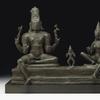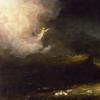Portrait of an 18th Century Legend Uncovered by Philip Mould
- LONDON, United Kingdom
- /
- April 17, 2012
The earliest surviving formal portrait of a male transvestite has been discovered by Philip Mould in a New York saleroom. On first glance the historic portrait featuring a rather masculine looking woman piqued the renowned art sleuth’s interest. A gentle clean and further painstaking research uncovered a rich and colourful history.
The 18th century portrait appeared to be of a somewhat manly middle-aged lady. Research before the sale suggested otherwise, and upon cleaning, the face revealed a distinctive 5 0’clock shadow. This fuelled further investigation that resulted in the astonishing discovery that the portrait is of the legendary spy, diplomat and transvestite, Chevalier D’Eon that has been lost since 1926.
The painting is now “under serious consideration” by the National Portrait Gallery, London. Should it be purchased, the portrait will represent the gallery’s first oil painting of a cross-dresser in guise.
“The story of D'Éon is one of the more remarkable biographies of the 18th century. The recent rediscovery of this lost and only oil portrait should dramatically reawaken his historical significance,” adds Philip Mould.
The picture will be on display at Philip Mould & Company, 29 Dover St from Monday 16th – Friday 20th April 2012 (excluding Wednesday morning).
Although some line engravings and satirical prints survive, until the re-discovery of this lost portrait last year no illuminating portrait of D’Eon was known to survive. The painting emerged, fittingly for the sitter, as ‘Portrait of a Woman with a Feather in her hat’, as attributed to Gilbert Stuart, as part of a general antique paintings auction a Thos. Cornell Galleries Ltd, New York, in November last year. It was part of the collection of Ruth Stone, daughter of Samuel Klein of Klein’s Department Stores, USA.
Research undertaken by Philip Mould Ltd has since proved that the picture is by the theatrical artist called Thomas Stewart who specialised in painting actors and theatrical scenes in London in the 1790’s – the same time as D’Eon was performing on stage as a fencer in drag. D’Eon is known as the “Patron Saint of Transvestites” and the word “eonism” meaning cross dressing and cross-sexuality derives from him.
D’Eon was the son of middle class, provincial French parents and having excelled at school in 1756 the brilliant graduate was recruited by the top-secret network of spies called Le Secret du Roi, which worked personally for King Louis XV. The monarch sent D'Éon on a secret mission to Russia in order to meet Empress Elizabeth and intrigue with the pro-French faction against the Habsburgs. Later tales claim that D'Éon disguised herself as a lady to do so, and even became a maid of honour to the Empress.
In 1763, having spent a heroic spell in the French dragoon guards where he distinguished himself as a master fencer, D’Eon was sent by Louis to London with the title Special Ambassador from France. His true mission was to spy for the king and collect information for a potential invasion - an initiative of which Louis's ministers were unaware. Despite remaining private documents that prove he was buying female corsets, at this stage D’Eon kept his transvestite proclivities clandestine.
After a year, D’Eon was replaced as ambassador by the aristocratic Count of Guerchy. Furious and humiliated by being reduced to his former rank as secretary, D'Éon decided to disobey orders to return to France, claiming that the new ambassador had tried to murder him. In an effort to save his position in London, D'Éon published most of the secret diplomatic correspondence. This breach of diplomatic protocol was unprecedented and scandalous, but D'Éon was careful to keep back from publication the King's secret invasion documents and those relative to the Secret du Roi as "insurance". With the invasion documents in hand, D'Éon held the king in check, and continued to work as a spy. But he could not return to France.
At this point D’Eon began to dress publicly as a woman, the motives for which are not entirely clear, and a betting pool was started on the London Stock Exchange about his true sex.
Observers described him as elaborately attired as a woman, but with masculine traits such as stubble and a tendency to hitch his skirts up when climbing stairs – all characteristics which have become more comprehendible since the emergence of the lost portrait. He was noted for his great intelligence and intellect but also his boorish lack of female charms. 18th century society found it much more acceptable to calibrate him as a masculine woman rather than a cross-dressing man.
In 1774, after the death of Louis XV, D’Eon tried to negotiate a return from exile. The resulting twenty-page treaty permitted him to return to France and keep his ministerial pension, but required that he not only turn over the secret correspondence on the Secret du Roi, but also that he dress in women's clothing. D'Éon agreed, especially when the king granted him funds for a new wardrobe. In 1777 after fourteen months of negotiation, D’Eon returned to France, and was banished to his home town of Tonnerre for six years. His family vineyard still produces wine to this day – the label decorated with feathers.
D'Éon returned to England in 1785. He lost his pension after the French Revolution and had to sell an extensive library that had been his life’s passion. Impoverished but still celebrated, D’Eon took to the stage in London and Dublin where he performed as a renowned female fencer in tournaments and spectacles until seriously wounded in 1796.
In 1804 he was imprisoned for debt but released in 1805, upon which a contract was signed for an autobiography. The book was never published because D'Éon became paralyzed following a fall.
D'Éon's last years were spent with a widow called Mrs. Cole. Doctors who examined the body after death discovered that the Chevalier was anatomically male.
The painting was almost certainly commissioned by the Earl of Moira, an 18th century Irish soldier, playwright and patron of the arts, and passed through his family till the 1850’s when it was given to George III’s ex-doctor – possibly as a mark of its medical curiosity. Descendants of the doctor sold it to an American collector at the beginning of last century, since which time it had vanished.
















